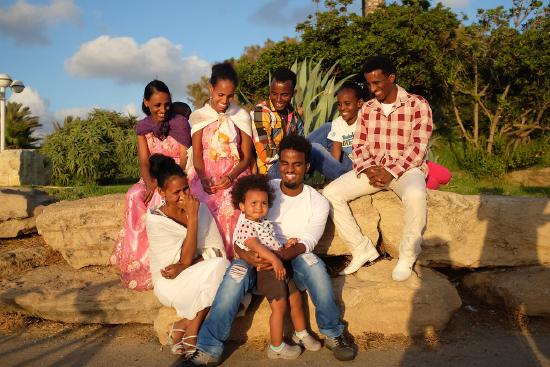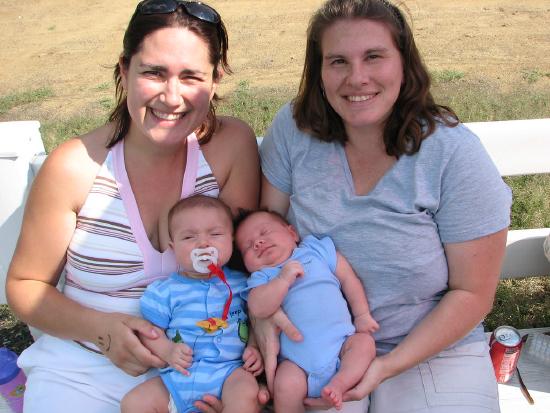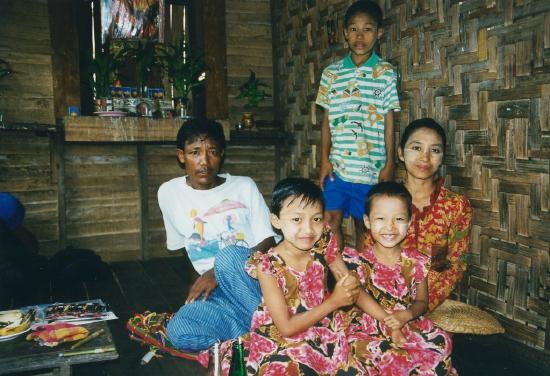3.1: La famille
( \newcommand{\kernel}{\mathrm{null}\,}\)
In this section, you will learn how to:
- Identify family members
- Talk about family relations
Listen to the audio clips that follow on this page to hear the French pronunciation of vocabulary and examples presented.
On étudie !

 "Father" by designerlisahenry, pixabay is in the Public Domain
"Father" by designerlisahenry, pixabay is in the Public Domain



 "Bago, Myanmar family" by Arian Zwegers is licensed under CC BY 2.0
"Bago, Myanmar family" by Arian Zwegers is licensed under CC BY 2.0In this section, we are going to talk about our families. Here's some vocabulary you need to know:
| Français | English |
|---|---|
| la famille | family |
| les parents | parents |
| la mère | mother |
| la belle-mère | mother-in-law, stepmother |
| le père | father |
| le beau-père | father-in-law, stepfather |
| l'époux | spouse (m.) |
| l'épouse | spouse (f.) |
| la femme | wife |
| le mari | husband |
| le, la conjoint(e) | partner |
| la sœur | sister |
| la belle-sœur | sister-in-law |
| la demi-sœur | half sister |
| le frère | brother |
| le beau-frère | brother-in-law |
| le demi-frère | half brother |
| l'enfant (m., f.) | child |
| les enfants | children |
| le papa | dad |
| la maman | mom |
| la fille | daughter |
| la belle-fille | stepdaughter |
| le fils | son |
| le beau-fils | stepson |
| les grands-parents | grandparent |
| la grand-mère | grandmother |
| le grand-père | grandfather |
| les petits-enfants | grandchildren |
| le petit-fils | grandson |
| la petite-fille | granddaughter |
| l'oncle | uncle |
| le tonton | uncle |
| la tante | aunt |
| la tatie | aunt |
| le neveu | nephew |
| la nièce | niece |
| le cousin | cousin (m.) |
| la cousine | cousin (f.) |
| le papi | grandpa |
| la mamie | grandma |
Listenand practice pronouncing these words here: la famille
Go to this link and click on each family member and you will hear how the word is pronounced.
You can identify which side of the family your grandparents are from with the adjectives paternel(le), maternel(le):
| Mother's side of the family | Father's side of the family |
|---|---|
| grand-mère maternelle | grand-mère paternelle |
| grand-père maternel | grand-père paternel |
You can also distinguish between your famille proche (immediate family) and your famille éloignée (distant family).
To highlight ages differences among siblings you can use the adjectives aîné(e) (older, born earlier) and cadet(te) (younger, born later)*. You could also use the adjectives grand(e) vs. petit(e):
| brother | sister | |
|---|---|---|
| older | frère aîné | sœur aînée |
| younger | frère cadet | sœur cadette |
| brother | sister | |
|---|---|---|
| older | grand frère | grande sœur |
| younger | petit frère | petite sœur |
* If there are 3 siblings, then the oldest is called l’aîné(e), the middle child is called le cadet, la cadette, and the youngest one is called le benjamin, la benjamine.
Types de famille
| Français | Anglais |
|---|---|
| famille nucléaire | nuclear family |
| famille étendue | extended family |
| famille en union libre | non-marital family |
| famille monoparentale | single-parent family |
| famille homoparentale | homoparental, same-sex parent family |
| famille adoptive | adoptive family |
| famille d'accueil | foster family |
| famille pacsée | family with parents in a civil union |
| famille polygame | polygamous family |
| famille tribu | tribal family |
| famille avec des parents séparés | family with separated parents |
| famille divorcée | family with divorced parents |
Here is some additional vocabulary that may be useful:
| Français | Anglais |
|---|---|
| épouser | to marry |
| divorcer | to divorce |
| voisin(e) | neighbor |
| célibataire | single |
| divorcé(e) | divorced |
| fiancé(e) | engaged |
| marié(e) | married |
| séparé(e) | separated |
| veuf, veuve | widow |
Study the Quizlet vocabulary flashcards. Listen and repeat the French pronunciation.
Watch these videos to practice talking about your family:
| Pronoms sujets | Français | Anglais |
|---|---|---|
| je | mon, ma, mes | my |
| tu (familier singulier) | ton, ta, tes | your |
| il, elle | son, sa, ses | his or her or its |
| nous | notre, nos | our |
| vous (1 personne formelle ou pluriel) | votre, vos | your |
| ils, elles | leur, leurs | their |
Pour en savoir plus.
On pratique !
Activité A
Parle-moi de ta famille.
Étudiant(e) 1 : Parle-moi de ta famille. Est-ce que tu as des frères et sœurs ?*
Étudiant(e) 2 : Oui, j'ai un frère et deux sœurs. Et toi ?
Étudiant(e) 1 : Moi, je n'ai pas de frères ou de sœurs.
Pratiquez ➔
Étudiant(e) 1 : Parle-moi de ta famille. Est-ce que tu as des frères et sœurs ?
Étudiant(e) 2 : ________. Et toi ?
Étudiant(e) 1 : ________.
*frères = brothers; sœurs = sisters
Activité B
Combien de personnes y a-t-il dans ta famille ?
The two friends in the video ask and answer how many people there are in their family.
To practice, you can listen and repeat.
Étudiant(e) 1 : Combien de personnes y a-t-il dans ta famille ?
Étudiant(e) 2 : Dans ma famille, on est huit. Nous sommes huit.
Pratiquez ➔
Étudiant(e) 1 : Combien de personnes y a-t-il dans ta famille ?
Étudiant(e) 2 : Il y a huit personnes dans ma famille.
Sophie : Comment s'appellent tes parents ?
Robert : Ils s'appellent Guillaume et Aïsha. Et toi ?
Sophie : Mes pères s'appellent Omar et Luc.
Colette : Combien de cousins as-tu ?
Mathis : J’ai deux cousins et une cousine.
Sylvie : Il a quel âge ton frère ?
Thierry : Il a 18 ans.
Sabine : As-tu une grande famille ou une petite famille ?
Florian : J’ai une très grande famille.
On approfondit !
Use the following resources to type accents and/or search for words:
- Accents: ç, à, é, è, â, ê, î, ô, û, ù, ë, ï, ü
- Dictionnaire français-anglais


